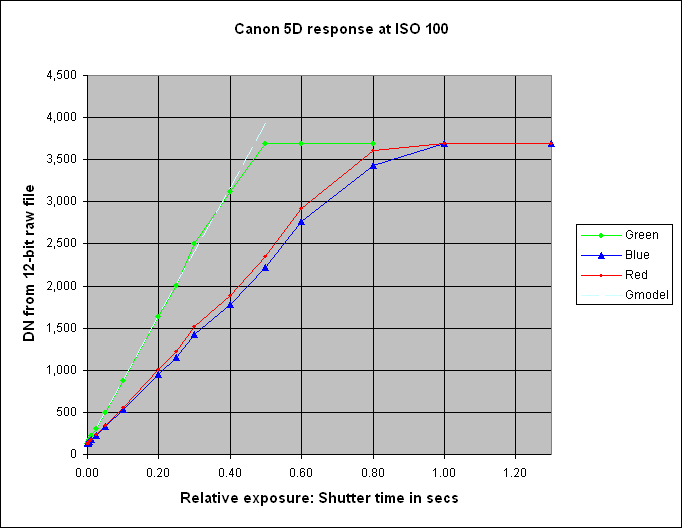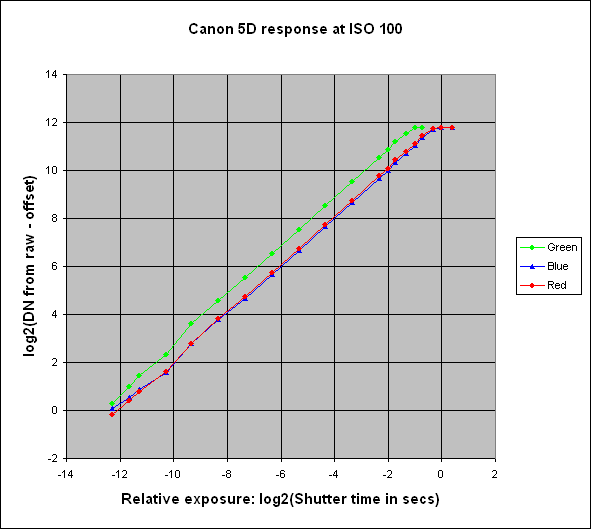We want to find out how the numbers in the raw file relate to the exposure that the sensor has received. We can also use the same measurements later to calculate the signal to noise ratio.
We photograph a flat target of uniform reflectance that is evenly illuminated. We use a fixed aperture but vary the shutter speed over a wide range so that we have shots that are heavily under-exposed, heavily over-exposed, and also a fair number at intermediate points. We take two shots at each shutter speed so that we can subtract them later to get the noise.
The exposure should not be too long, or the sensor response will be increased due to heating. Roger Clark recommends a shutter speed not longer than 2 seconds whereas Christian Buil says not longer than 1/100 second.
We use a long lens, 1.5m from the target, but focus it at infinity thus creating a highly defocussed image. This minimises any non-uniformities in the target.
We use a medium-sized aperture. A small aperture would exaggerate any dust spots that may be on the sensor. A large aperture would cause vignetting (i.e darkening of the corners) of the image. Whilst vignetting doesn't affect the measurements we are going to make, because we only measure a small area in the centre of the frame, it does make the histogram that appears on the back of our camera into a broad hump rather than a sharp spike. The latter is more useful when assessing whether we have under- or over-exposed enough.
One of the things we can deduce from this test is the point at which the sensor limits - ie. the exposure above which additional light striking the sensor does not increase the number in the raw file. We want one of our test exposures to be close to, but just short of, that limit. Therefore, as we approach that limit, we need to increase the shutter time between successive pairs of exposures by the minimum increment the camera supports which, in the case of the Canon 5D, is 1/3 of a stop.
Another point that needs to be borne in mind is that the red, green and blue sensor wells may limit at different exposures. This might be because the Bayer filters have differing transmission, or it might be that our target illumination is not pure white light. In fact, any kind of studio lighting is likely to be weak at the blue end of the spectrum. This means we have to expose further beyond the right-hand end of the histogram to be sure that we have reached the blue limit.
Whilst the above sounds simple enough, I found it quite difficult in practice and had to take several test sequences before I was satisfied that I was using an appropriate range of exposures. I ended up using exposures up to 1.6 seconds and, although this is within Roger Clark's 2 second limit, I definitely noticed that the second of the two exposures was very slightly lighter than the first, which must be due to a sensor heating effect. I therefore imposed a ten second delay between exposures at these longer shutter speeds.
For ISO 100, I ended up with 21 pairs of images, each pair taken at a different exposure. The aperture was f/9 and the shutter speeds varied from 1/5000 to 1.6 seconds. The statistics of a 200 x 200 pixel area in the centre of the image for the green wells are in the table below:
Looking at the Mean DN column, it is obvious that for the longest six exposures the number in the raw file is the same at 3692, and the standard deviation of that value is zero. This tells us that the firmware is clipping the numbers in the raw file at 3692, which is 403 short of the maximum output of the camera's 12-bit ADC.
The data for the red and blue wells is similar, except that longer exposure is needed to reach the clipping point. The full table of results at ISO 100 is here.

The graph shows the response of all three colours on linear scales.
All three colours limit at the same value of 3692. We know that the intercept on the Y axis should be 128, which is the offset we previously measured.
As already mentioned, the fact that the green curve is steeper than the other two may simply be due to the lighting of the target being more intense in the green than the blue region of the spectrum.
The dashed white line is the best straight line fit to the green points, ignoring the top three.
The equation is
DN = 7597 * T + 128,
where T is the shutter time in seconds. R² = 0.9992 (Of course, the slope of this line only applies to the
particular target and illumination used. It is done to demonstrate the linearity, see the right-hand two columns of the table above)
The linearity in the green is better than 4% until saturation begins, and is generally better than 2%.
Because of the linear exposure time scale, many of the data points are crowded in the bottom left corner. A better view is given by plotting the same data on logarithmic scales:

The horizontal axis is relative exposure in photgraphic stops. The offset has been subtracted from the DN values (not that this matters on a log plot).
This gives a better impression of the linearity of the camera's response. The range of the linear region can be seen to be about 11 stops, but it does not follow that that is the camera's dynamic range, as we shall see later, because we also have to consider the noise.
Peter Facey, Winchester, England
20080129 originated